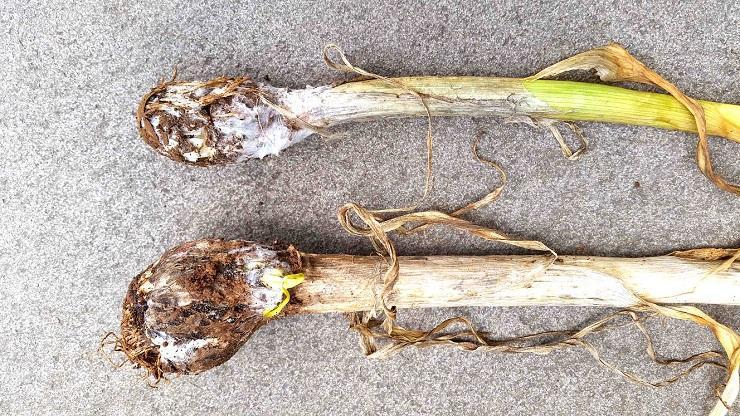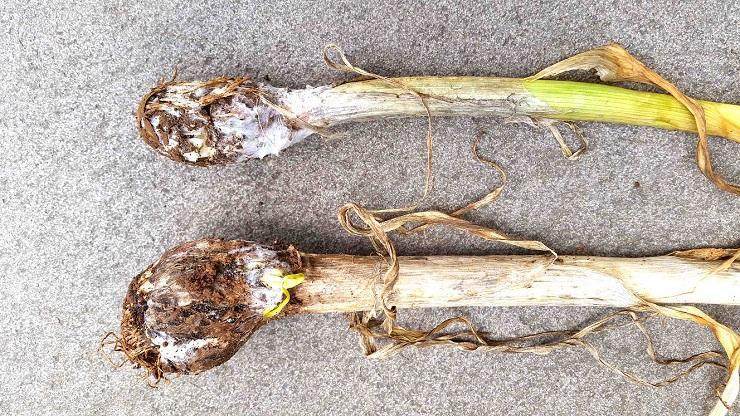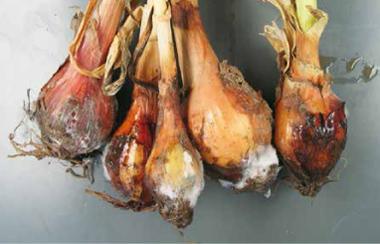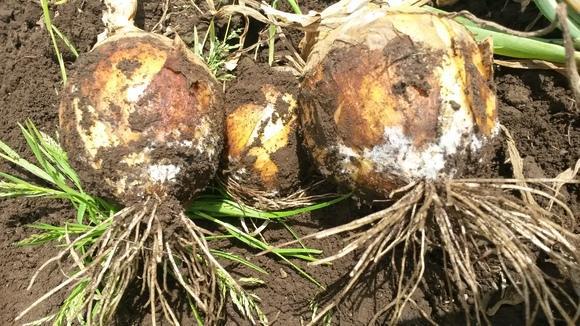White rot of onion and garlic (Stromatinia cepivora) – identify and control

White rot of onion and garlic, Stromatinia cepivora was first reported in 1841 in England. It has spread to all countries that cultivate the Allium species. During the rainy years, high temperatures cause damage that can compromise even 70% of the harvest.



Symptoms. During wet springs, in March-April, the yellowing of the leaf tips may occur. This yellowing slowly progresses towards the base of the leaves and leads to the plants’ deaths. The attack can have a circular or elongated shape, it is present along the rows. The plants have their roots and tunics rotten and covered by a white and fluffy mycelium, where the small, black, and spherical sclerotia grow, which are 0.2-0.5 mm in diameter. The plant rot continues in warehouses. The fleshy parts of the bulbs are soft, rotten, and can be invaded by bacteria.
White rot of onion and garlic survives in the soil for 4-5 years through the sclerotia that are carried by irrigation water or by maintenance procedures, ensuring the spread of the pathogen. The sclerotia can also be seen on the bulbs destined for planting, especially on the garlic. Sclerotia keep their viability for 4-5 years. They can cause new root infections even a month after they have been formed. The crops normally have 2 periods of maximum plant sensitivity towards this fungus. One in March-April and the other one is after the bulbs have been formed and even after harvesting, as the attack of this fungus is favored by the wounds that can appear on the roots and bulbs. The plants growing in colder and damper soils are more sensitive because the fungus can attack if the temperatures are between 2 degrees Celsius, up to 35 degrees Celsius, when the mycelium is destroyed.
Prevention and control. The 5-6 year crop rotation, deep plowing, preceded by the burning of the attacked plant residues, balanced fertilization, the use of healthy bulbs at planting, and their preventive treatment limit the attack and damage.
During the vegetation period, treatments with specific fungicides are recommended.
Recommended products
-
You can find products on a different store
Change Store -
You can find products on a different store
Change Store -
You can find products on a different store
Change Store -
You can find products on a different store
Change Store -
You can find products on a different store
Change Store -
You can find products on a different store
Change Store -
You can find products on a different store
Change Store -
You can find products on a different store
Change Store -
You can find products on a different store
Change Store -
You can find products on a different store
Change Store -
You can find products on a different store
Change Store -
You can find products on a different store
Change Store -
You can find products on a different store
Change Store -
You can find products on a different store
Change Store -
You can find products on a different store
Change Store -
You can find products on a different store
Change Store -
You can find products on a different store
Change Store -
You can find products on a different store
Change Store -
You can find products on a different store
Change Store -
You can find products on a different store
Change Store -
You can find products on a different store
Change Store -
You can find products on a different store
Change Store -
You can find products on a different store
Change Store -
You can find products on a different store
Change Store















































































































































































































































































































































































































































